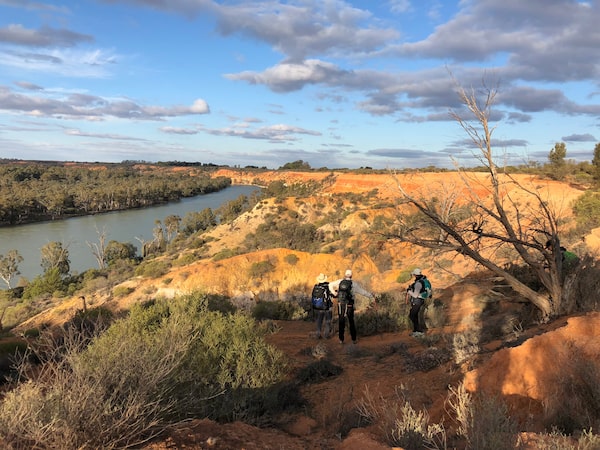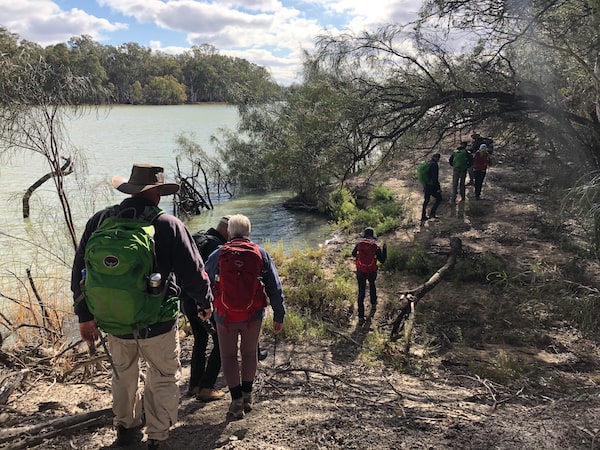
Hikers look out on the main tributary of Australia's Murray River.Jessica Wynne Lockhart/The Globe and Mail
Looking at a map of Australia, it’s easy to be misled by the dots of blue. Most of the country’s inland waterways are ephemeral – riverbeds that only rush once a year; salt flats that last held water decades ago; and wetlands that are anything but. Take Lake Eyre, for example: Australia’s largest lake only fills about once a decade.
That’s why the Murray River’s 2,508 kilometres is an unexpected shock in an otherwise sunburnt country. Now the third-longest navigable river in the world, it too was once dictated by a natural cycle of wetting and drying, until it was permanently flooded by a locks system in the 1920s. In South Australia’s Riverland region, farmers rejoiced. So did tourists – the first houseboat set sail from Renmark in the 1960s, with RVers and water skiers following.
It’s been a popular regional getaway since then; yet, it remains relatively undiscovered by international visitors. A three-hour drive east of Adelaide, Renmark is a solid trek from the perennially popular Great Barrier Reef, and further out still from the crowds at the base of Uluru. That may be set to change though, with the emergence of new tourism offerings such as the Murray River Walk.

The 40-kilometre Murray River Walk was launched three years ago, using wallaby trails as a guide.Jessica Wynne Lockhart/The Globe and Mail
Renmark local Tony Sharley launched the new 40-kilometre walk three years ago, mapping it out based on wallaby tracks. Sharley, an aquatic biologist by trade, wanted to create a route that wasn’t so much about travelling from point A to B, as it was about understanding the river’s history and ecology.
“Walking reinforces how the land connects with the water – on a boat ride, you often rush past it all,” he says.
Over four days, walkers explore the Murray’s main tributary and backwaters. Surprises, when they appear, are like Easter eggs: the vivid green of an Australian ringneck parrot contrasted against the bush’s muted browns and greens; a red kangaroo practising boxing on the river’s shore; and “canoe trees” scarred by Aboriginal watercraft-making. Then there are literal eggs, such as the speckled blue emu egg we find hidden on the ground.
Each day is spent moving through different ecosystems. Dry floodplains give way to red sandy soil littered with Murray lilies, before walkers pop out at the top of a peaches-and-cream cliffside. Nights are spent on a houseboat named Desire, refuelling for the day ahead with local wines, kangaroo osso buco, Murray River cod and quandong crumble.
On the boat, I sit with Cass, one of our guides and a self-proclaimed “twitcher.” At only 24, she can identify many of the Riverland’s 200 bird species with ease. As we float past river red gums holding whistling kite nests aloft, Cass tells me how the Riverland has transformed since her childhood family vacations to the area.
“It’s not iconic yet, but it’s making a name for itself,” she says confidently.
She’s not the only one who believes the Murray River is on the precipice of change. This year, construction started on the Murray River Adventure Trail, which once completed roughly in 2029, will be the longest multimode trail in the world with thousands of kilometres of on-land and on-water experiences.
It’s also why five years ago Rick and Cathy Edmonds built three riverfront villas, known collectively as the Frames. The Edmonds’ decision to open luxury accommodation in an agricultural town of 9,500 raised more than a few eyebrows. But for the third-generation farmers, the timing felt right.
“It wasn’t about the accommodation – it was about the Riverland region as a destination,” Cathy tells me over dinner at Mallee Estate, one of the area’s 16 wineries.
On the Frames’ “Flavour Safari” tour, for example, visitors sample Renmark-grown almonds, try beer made with wattleseed extract at the Woolshed Brewery and even help pick oranges on the Edmonds’ farm. It’s a gentle reminder that the Murray wasn’t flooded for tourism, but for irrigation – today, the “fruit bowl of Australia” produces more than 30 per cent of the country’s citrus fruits and 27 per cent of its wine grapes.
The next day, after a morning spent watching pelicans catch cliffside thermals, Rick and Cathy pick me up for a tour of the Murray’s backwaters. Our boat cuts through the river’s milky jade waters and Rick cuts the engine so we can watch a pair of black swans with their chick.
His grandmother, he says, used to tell him stories of what it was like before the Murray was flooded – stories of a time when she could step over the river in a single stride. Now, he says, the Murray provides security to farmers in times of drought.
“No matter what,” says Rick, “the river will always be the hero.”
Your turn
With weekly departures running from May to September, the guided Murray River Walk is a well-paced 40-kilometre four-day journey, with walking poles and packs provided. Guests spend three nights sleeping aboard a 10-berth modern houseboat, with a top deck hot tub. Prices start at $2,500 AUD (about $2,360) a person, and are inclusive of meals and alcohol. murrayriverwalk.com.au
How to get there
The gateway to the Riverland region, Renmark is located a three-hour drive east of Adelaide, South Australia. If you’re not comfortable driving a rental on the “wrong” side of the road, Bus Biz offers door-to-door transfers. busbiz.net.au
Stay
Murray River Walkers receive a special rate at the centrally located Renmark Hotel, which has been community-owned since 1897 and is the starting point for the tour. renmarkhotel.com.au
For a postwalk treat, the award-winning Frames are self-contained villas in nearby Paringa. Overlooking the river, each has its own private outdoor area, with splashy features perfect for sore feet, like heated pools, saunas and gas fireplaces. theframesluxuryaccommodation.com.au
The writer was a guest of Tourism South Australia. It did not review or approve this article.
Live your best. We have a daily Life & Arts newsletter, providing you with our latest stories on health, travel, food and culture. Sign up today.